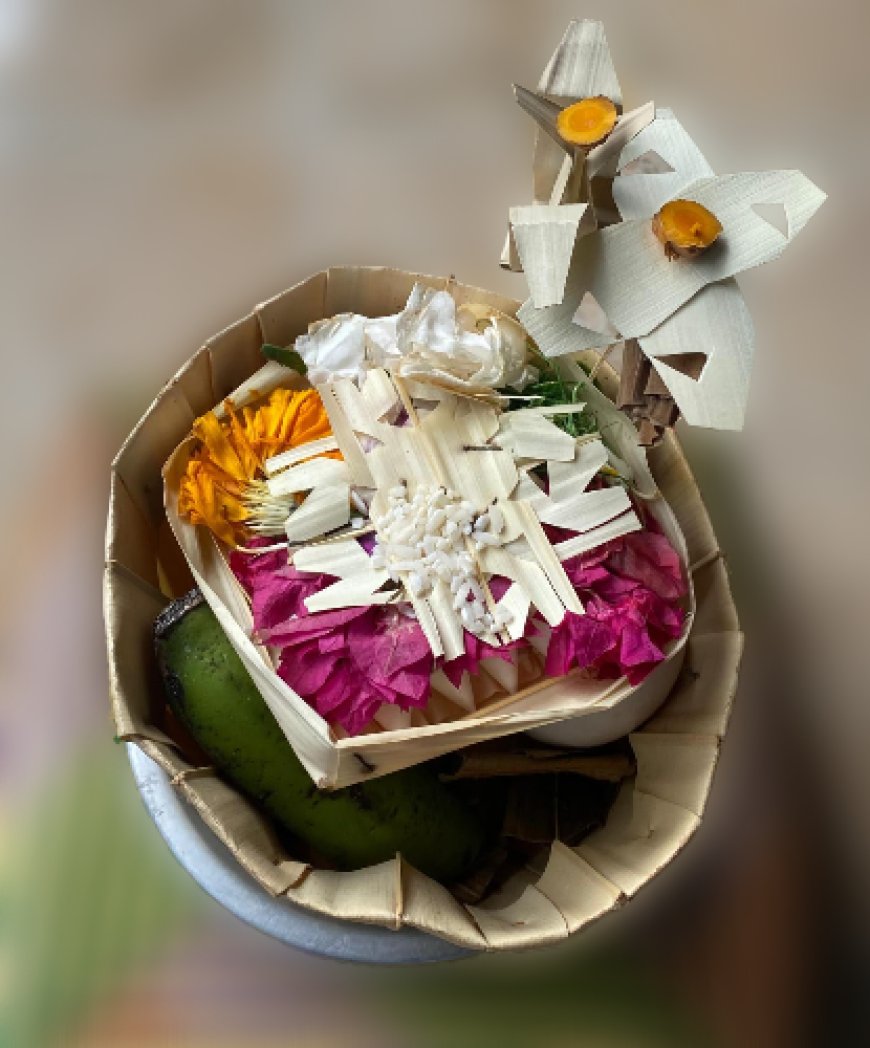Daksina: Yadnya Wife, Symbols of Life, and Worship
Daksina is a sacred offering in the Balinese Hindu tradition that symbolizes balance and reverence to God. This offering holds philosophical values, maintaining positive energy and inner peace. Through daksina, people are taught humility and gratitude. Daksina also strengthens spiritual connections and harmony with nature.


Components of Daksina (Source: Personal Collection)
Daksina is not merely an offering; it embodies profound philosophical values. Each component of daksina has a symbolic meaning that represents various aspects of life and the universe.
-
Alas Bedogan and Bedogan: The alas bedogan and bedogan are made from young coconut fronds shaped in circles and sized according to the wakul. The alas bedogan symbolizes Mother Earth, the visible symbol of the ground we stand on. The bedogan in the center, which is a circle without edges, symbolizes Akasa, the boundless sky, representing the universe. Together, they represent the unity of earth and sky as symbols of the balance of the universe.
-
Srembeng Daksina: Srembeng Daksina symbolizes the Law of Rta, the eternal law of God that governs the universe. It represents the order of the cosmos and the manifestation of God as Mother Earth, which serves as the foundation of life.
-
Tampak Dara: Tampak Dara is formed from two pieces of coconut frond sewn together into a plus sign (+), symbolizing the balance between the Makrokosmos (the greater universe) and Mikrokosmos (the smaller universe). It also represents the Swastika, a symbol of universal virtue and Rta, order, which is the manifestation of God as the duality of Rwa Bhineda.
-
Rice: Rice symbolizes the source of human livelihood as a product of the earth. It represents Hyang Bayu, who embodies the life force and prosperity given by God to humanity.
-
Porosan (Betel Leaf Offering): Porosan is made from betel leaves, lime, and areca nuts, each representing Vishnu (green), Shiva (white), and Brahma (red). It symbolizes worship and represents Kama, the force of love and unity, as the manifestation of God through Hyang Semara, the god of love.
-
Coconut: Coconut symbolizes Pawitra or the water of eternity, representing the universe with its seven inner layers and seven outer layers (Sapta Loka and Sapta Patala). It symbolizes the Sun and the manifestation of God as Hyang Surya, who gives life to the universe.
-
Duck Eggs: Duck eggs are wrapped in ketupat, symbolizing the beginning of life and the vibrations of life in nature. They also symbolize Bhuana Alit, or the small world consisting of the physical body, subtle soul, and inner spirit of humans.
-
Banana, Sugarcane, and Kojong: Bananas symbolize human fingers, sugarcane symbolizes bones, and kojong (young coconut leaves) symbolize the human body. These represent humans as part of nature living according to Tri Kaya Parisudha, the three sacred actions: thinking, speaking, and doing good.
-
Candlenut: Candlenut symbolizes Purusa (masculine soul) with its white color symbolizing purity. It is a symbol of the star and the manifestation of God as Hyang Tranggana, the god of stars and light.
-
Kluwek/Pangi: Kluwek fruit symbolizes Pradhana (feminine material strength) with its red color representing power. It also symbolizes the Sea and is the manifestation of God as Hyang Baruna, the god of the ocean.
-
Gegantusan: Gegantusan is a combination of land and sea products, including nuts, spices, salt, and anchovies. It symbolizes Sad Rasa (six tastes) and prosperity and is a symbol of the mysterious world, the manifestation of God as Hyang Indra, the god of rain and prosperity.
-
Papeselan: Papeselan consists of five types of leaves representing Panca Devata: Isvara (duku leaves), Brahma (manggis leaves), Mahadeva (durian leaves), Vishnu (salak leaves), and Shiva (jackfruit leaves). It also symbolizes Tri Hita Karana, which is the harmonious relationship between God, humans, and nature.
-
Bija Ratus: Bija ratus is a mixture of five different colored grains, each representing the main gods: Vishnu, Isvara, Brahma, Mahadewa, and Shiva. It is a symbol of blessings and unity presented to God.
-
Benang Tukelan: Benang Tukelan symbolizes the dragons Anantabhoga, Basuki, and Taksaka, who were involved in the churning of Mount Mandara to seek the water of immortality. It symbolizes cosmic power and the spiritual binding that maintains the balance of the universe.
-
Kepeng Money: Kepeng money is a symbol of Brahma, the creator god, and represents prosperity and the source of life. It is used as a symbol of redemption for human shortcomings in karma (actions).
-
Sesari: Sesari symbolizes the essence or core of karma, which is the result of human actions. It is given as a sign of gratitude for all the blessings received from efforts and hard work.
-
Sampyan Payasan: This symbolizes utpeti, sthiti, and pralina, while Sampyan Pusung signifies the ultimate purpose.

Daksina, a Symbol of Gratitude and Harmony in Balinese Hindu Tradition (Source: Personal Collection)
Daksina is also rich in symbols of a broader life, not only for humans but also for maintaining the balance of the cosmos or the universe. The composition in daksina is considered a representation of natural elements such as earth, water, fire, air, and akasa (space). Through rituals involving daksina, Balinese Hindus aim to maintain harmony between living beings, nature, and supernatural forces.
By presenting daksina, it is hoped that Hindus can lead a balanced life, full of blessings, and harmony. As one form of yadnya, daksina also teaches the importance of humility and gratitude in every aspect of life, both material and spiritual.
In addition to its symbolic and philosophical values, daksina also has great spiritual benefits for Hindus. Daksina is believed to help maintain the balance of positive energy in the household, bring inner peace, and strengthen the spiritual relationship between the devotee and God. This offering also serves as a reminder for devotees to always act virtuously and maintain the purity of thought, speech, and action in daily life.































































